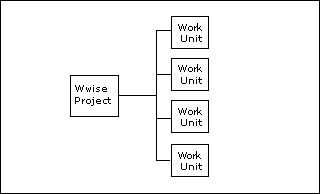In today's game environment, with the complexity of games and the pressure to get games to market, it is essential for sound designers, music composers, audio integrators, and audio programmers to be able to work together on the same project. In Wwise, you can do this using Work Units and source control.
You must use only one Wwise project per game. In order for several people to work efficiently on the same project, it must be broken up into smaller pieces. In Wwise, these pieces are called Work Units.
These Work Unit files can be then be managed by your source control system.
Each person in your team can then work on the same or different parts of the project in parallel.
In most cases, you will want different people working on different parts of the project in order to avoid difficult and frequent merging issues. However, there will be cases when two or more people will have to work on the same Work Unit concurrently. When these files are checked back in to your source control system, you will most likely have to deal with merge conflicts. Refer to your source control documentation for more information on how best to deal with merge conflicts.
Although Wwise is not a source control management system, you can use its open architecture to easily integrate your existing source control system. This allows you to manage your project assets and perform many of your source control functions directly in Wwise. For more information on the Wwise source control plug-in, refer to Managing project files with a source control plug-in.
![[Note]](/images/2023.1.3_8471/?source=Help&id=note.png) | Note |
|---|
In order to create a Source Control plug-in, your source control system needs to support
third-party integration using their API. Perforce and Subversion plug-ins are
installed with Wwise. |
Work Units are distinct XML files that contain information related to a particular section or element within your project. These Work Units can help you organize and manage the different elements within a project. If you are working as part of a team, these Work Units can also be managed by your source control system to make it easier for the different members of your team to work on the project concurrently.
When a project is created, a Default Work Unit is created for each of the following elements in Wwise:
These Default Work Units are located in their respective folders within your project directory. Each one is named “Default Work Unit.wwu.” The Default Work Units are created so that you can begin creating objects, Events, States, and so on, without having to create Work Units for each project element first.
As your project grows or if more people join the project team, you may want to divide up the different project elements into new Work Units. For example, you can create three different Work Units for states called StatesLevel1, StatesLevel2, and StatesLevel3.
If you decide to create new Work Units, you can leave the Default Work Units empty. The Default Work Units, however, are critical project files and should not be renamed or deleted. If you rename or delete these files, Wwise will recreate them the next time you open the project.
Work Units can be organized into physical sub folders on disk. The physical folder structure is replicated in the Project Explorer.
You can create new Work Units for all project elements.
The following example shows how Work Units can be created and organized to divide up the sound structures in the Actor-Mixer Hierarchy.
You can create and manage the contents of your Work Units in the different tabs of the Project Explorer. For more information about organizing your project into Work Units, refer to Dividing your project into Work Units.



![[Note]](/images/2023.1.3_8471/?source=Help&id=note.png)


